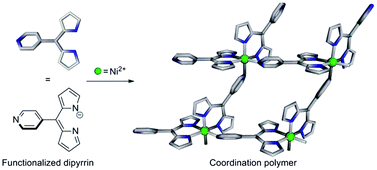Ni(ii) dipyrrin complexes bearing peripheral pyridyl or imidazolyl groups self-assemble into 2- and 3-D coordination polymers†
Abstract
While the numerous reported Ni(II) dipyrrin complexes are discrete species, derivatives bearing peripheral

* Corresponding authors
a
Laboratoire de Tectonique Moléculaire, UMR UdS-CNRS 7140, Université de Strasbourg, Strasbourg, France
E-mail:
hosseini@unistra.fr, sbaudron@unistra.fr
Fax: +33 368851325
Tel: +33 368851323
b Institut de Physique et Chimie des Matériaux de Strasbourg, UMR UdS-CNRS 7504, Strasbourg, France
While the numerous reported Ni(II) dipyrrin complexes are discrete species, derivatives bearing peripheral

 Please wait while we load your content...
Something went wrong. Try again?
Please wait while we load your content...
Something went wrong. Try again?
A. Béziau, S. A. Baudron, G. Rogez and M. W. Hosseini, CrystEngComm, 2013, 15, 5980 DOI: 10.1039/C3CE40762D
To request permission to reproduce material from this article, please go to the Copyright Clearance Center request page.
If you are an author contributing to an RSC publication, you do not need to request permission provided correct acknowledgement is given.
If you are the author of this article, you do not need to request permission to reproduce figures and diagrams provided correct acknowledgement is given. If you want to reproduce the whole article in a third-party publication (excluding your thesis/dissertation for which permission is not required) please go to the Copyright Clearance Center request page.
Read more about how to correctly acknowledge RSC content.
 Fetching data from CrossRef.
Fetching data from CrossRef.
This may take some time to load.
Loading related content
